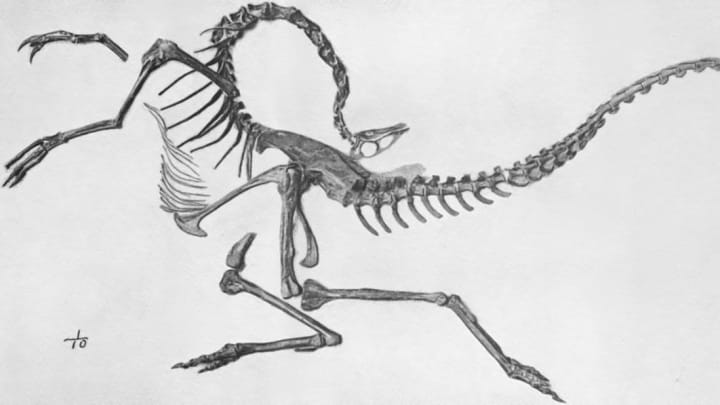Scientists Find Blood Cells in 75-Million-Year-Old Dinosaur Bones

An early 20th-century illustration of a Struthiomimus altus, a theropodspecies known from Dinosaur Provincial Park in Alberta, Canada. Scientists have found evidence of soft tissue in the claw of a 75-million-year-old theropod like this one.
For Dinosaur Provincial Park, one of the richest, best-preserved fossil sites in the world, the bones are nothing special. They were found a century ago on the surface in a poorly preserved state. They spent decades in museum storage, ignored.
But these humble bones from Alberta, Canada, may hold something remarkable: 75-million-year-old soft tissue. That's what researchers from Imperial College London reported on June 9 in Nature Communications. “We still need to do more research to confirm what it is that we are imaging in these dinosaur bone fragments, but the ancient tissue structures we have analyzed have some similarities to red blood cells and collagen fibers," says study co-author Sergio Bertazzo. "If we can confirm that our initial observations are correct, then this could yield fresh insights into how these creatures once lived and evolved.”
Using a scanning electron microscope, a focused ion beam, and a transmission electron microscope, the team looked deep into the interiors of eight bone fragments, among them a claw from a theropod dinosaur. In six of the fragments they found evidence of soft tissue, including possible fibers and amino acids from collagen (a protein mostly found in tendons, ligaments, and skin) and erythrocytes, or red blood cells. The red blood cells show a surprising similarity to modern emu blood, they report.
Density-dependent color scanning electron micrographs of an ungual claw of an indeterminate theropod dinosaur and ribs from an indeterminate dinosaur. Researchers found (a) amorphous carbon-rich material (red) surrounded by dense material (green); (b) red blood cell–like structures composed of carbon; and (d) fibrous structures. Image credit: Sergio Bertazzo
The findings are notable because when soft tissue has been discovered—very rarely—in the past, it has almost invariably been found in pristinely preserved fossils. But a decade ago, the discovery of soft tissues in a Tyrannosaurus rex astonished paleontologists by revealing soft tissue preservation where nobody thought it possible, says David Evans, a paleontologist at the Royal Ontario Museum who has worked extensively at Dinosaur Provincial Park. "These findings were controversial, were generally thought to be restricted to special, spectacular preservational conditions, and very rare," he says.
This recent analysis bolsters those findings and suggests we may be able to mine soft tissue from even poorly preserved bones. "It has huge potential for future research," Evans says. "It shows that preservation of soft tissues like blood cells and collagen might be much more common in dinosaur bones that we have previously assumed—we just need to look."